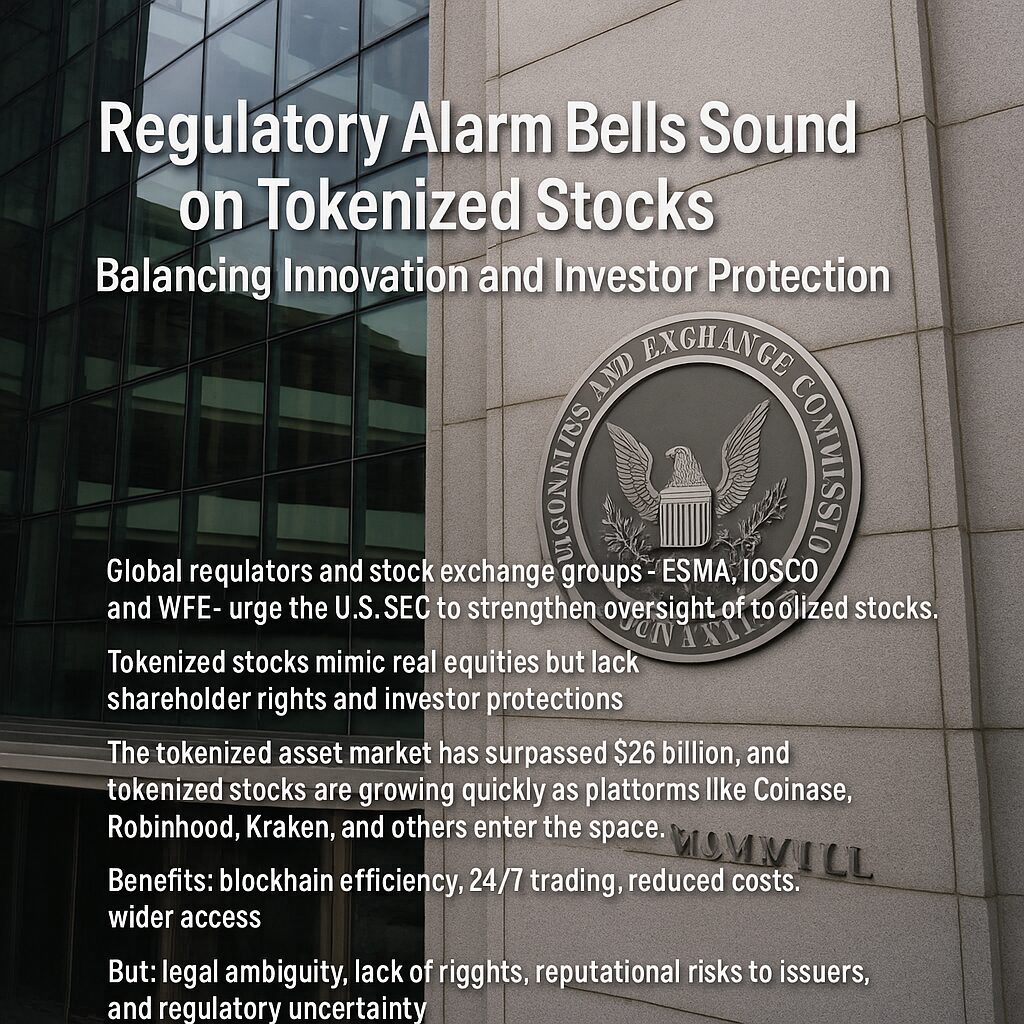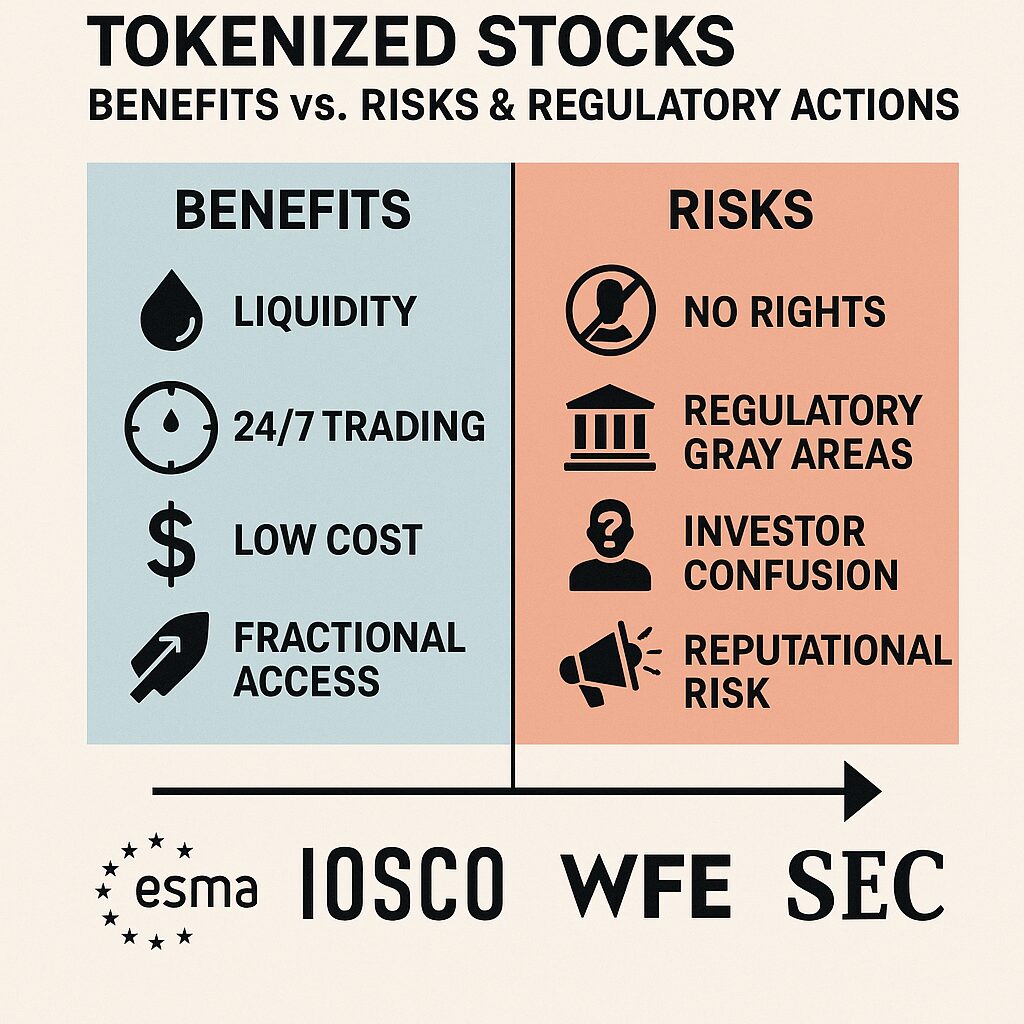
Main Points:
- Global regulators and stock exchange groups—ESMA, IOSCO, and WFE—urge the U.S. SEC to strengthen oversight of tokenized stocks.
- Tokenized stocks mimic real equities but lack shareholder rights and investor protections.
- The tokenized asset market has surpassed $26 billion, and tokenized stocks are growing quickly as platforms like Coinbase, Robinhood, Kraken, and others enter the space.
- Benefits: blockchain efficiency, 24/7 trading, reduced costs, wider access.
- But: legal ambiguity, lack of rights, reputational risks to issuers, and regulatory uncertainty.
- Regulatory pushback gains traction amid broader tokenization trends and divergent stances—for innovation vs. caution.
1. Regulatory Push for Stricter Oversight
Global securities regulators—including the European Securities and Markets Authority (ESMA), the International Organization of Securities Commissions (IOSCO), and the World Federation of Exchanges (WFE)—have sent a joint letter to the U.S. Securities and Exchange Commission’s (SEC) Crypto Task Force. They called for stronger regulation of tokenized stocks, warning that while these products replicate listed equities, they do not carry the same legal protections or shareholder rights. They expressed concern that investors may be misled by platforms portraying these tokens as equivalent to genuine stocks.
2. Market Size and Platform Expansion
Though still a relatively small part of the broader tokenized-asset ecosystem, the tokenized stock market is expanding rapidly. Industry data shows the total tokenized asset market has passed $26 billion. Key platforms like Robinhood, Coinbase, Kraken, and others are actively offering or planning to offer tokenized equities. Notably, Robinhood launched tokenized versions of over 200 U.S. stocks and ETFs for European users, including private companies such as OpenAI and SpaceX, enabling commission-free trading, although these tokens do not confer ownership.
3. Advantages of Tokenized Stocks
Proponents emphasize several benefits:
- Increased accessibility and lower barriers to entry, enabling fractional exposure to blue-chip assets.
- Round-the-clock trading and faster settlement through blockchain infrastructure.
- Cost-efficiency and enhanced liquidity through decentralized infrastructure.
4. Risks and Legal Concerns
Despite the efficiencies, serious concerns remain:
- Token holders do not carry shareholder rights, such as voting power or claims on underlying company assets.
- Marketing these tokens as equivalent to stocks could mislead retail investors and conflict with market integrity.
- Issuers like OpenAI have publicly denied involvement in token offerings making or referencing their shares.
- There is legal ambiguity, as parties have sought exemptions or relief from existing securities regulations.
5. Broader Tokenization Trends and Regulatory Divide
Tokenization of real-world assets is gaining momentum—transforming assets like real estate, art, and traditional securities into digital tokens. Projections estimate this market could reach $2 trillion by 2030, with institutional players such as Kraken and BlackRock already entering the arena. The SEC has taken a cautiously positive stance, labelling tokenization as innovation to be nurtured—but also emphasizing full compliance with securities laws.
Still, experts caution that the transformation of the financial system won’t happen overnight: structural, regulatory, and technical challenges remain deeply entrenched. Meaningful adoption may take years or decades, not just months.
Meanwhile, U.S. political shifts—from Biden’s cautious approach to Trump’s more crypto-friendly posture—add unpredictability to the regulatory landscape.Illustration (Insert here):
Infographic: “Tokenized Stocks – Benefits vs. Risks & Regulatory Actions”
- Left side: bullet visuals for benefits—liquidity, 24/7, low cost, fractional access.
- Right side: risks—no rights, regulatory gray zones, investor confusion, reputational risk.
- Bottom: logos of ESMA, IOSCO, WFE, SEC arrows indicating call for regulation.

6. Summary
Tokenized stocks represent the forefront of blockchain-driven innovation in finance, offering efficiency, access, and global trading potential. Yet, they also threaten traditional safeguards by sidestepping rights associated with real equity. With market growth surging and heavyweight platforms entering the space, regulatory bodies have responded swiftly—urging clarity, investor protection, and legal alignment. As tokenization continues to reshape asset markets, success hinges on a balanced approach where innovation thrives within robust, transparent rules.

